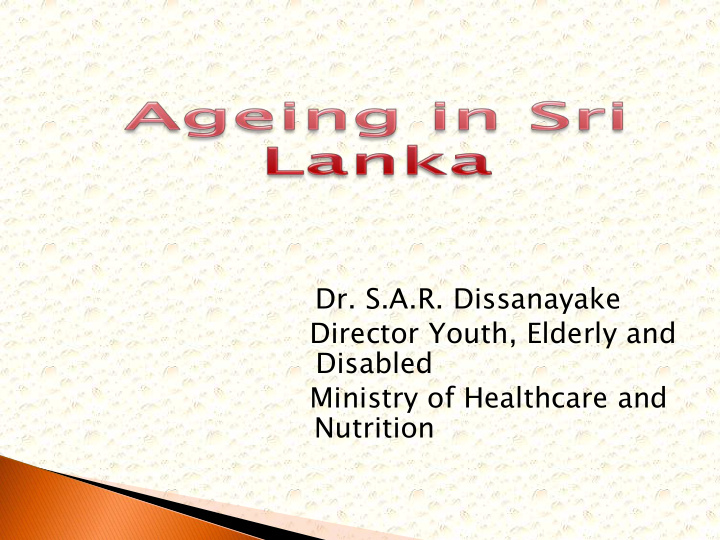



Dr. S.A.R. Dissanayake Director Youth, Elderly and Disabled Ministry of Healthcare and Nutrition
A person who has completed 60 years of age is considered as an Elderly
Is a biological process that starts from the date of conception and goes on until the death Is a global phenomenon Occurs due to changes in the physical psychological and functional arenas of an individual
This process can not to be stopped or reversed But quality can be altered Quality of this process is highly associated with socio-cultural, economical and environmental factors Interventions should be started as early as possible
• Physically 60-70 years – active, mentally alert and economically Young g old productive 70-85 years – Old old • Often physically frail Over 85 years – with different Oldest est old impairments and morbidity
Current-660 million By 2025-1200 million By 2050-1990 million 2/3 of them live in developing countries Population is rapidly ageing in countries like Japan, Singapore, Australia
2500 2000 1500 world Developing countries 1000 Developed countries 500 0 2002 2025 2050
Total population 4100 million Elders-410 million (10%) 733 million in 2025 1.3 billion by 2050 (25%) Older persons outnumbered children under 15yrs by 2008
Total population -20million Population over 60 yrs ◦ 1971-6.3% ◦ 2001-9.2% ◦ 2041-24.8% Highest in SE Asia Third highest percentage in Asia following Japan and Singapore
Today By 20-25years
Demands due to the Physical changes Care and services to address Mental changes Protection of rights and provide Social security
Reduction in growth Reduction in repairing capacity Reduction in functions of the immune system Reduction in muscle mass Reduction in capacity to respond to stress Anatomical changes occur in the brain and The rest of the body
Chronic Diseases Ischemic Heart Disease Hypertension Diabetes mellitus Chronic obstructive airways disease Degenerative diseases Cerebro-vascular accidents
Vision and Hearing impairment Poor Nutrition Cancers Frailty – disability/ bed ridden Cosmetic Changes Limitation of Functional capacities
Depression Memory impairment - Dementia - Alzheimer’s disease Loss of self Esteem Sense of burden to family and society Empty nest syndrome – feel lonely
Financial dependency No social security Ownership of properties Housing Non availability of services designed for their needs Food security Exploitation/Abuse
Due to rapid increase of Non Communicable Diseases along with the Demographic shift alteration of the disease pattern has taken place Considering all these factors existing health facilities should be designed to meet the demands of elderly
Multi sectoral approach Health services, Social Services and Media should play a key role Prioritize the issue Sufficient resource allocation
Elderly care is integrated to the public health care services as a priority Grass root level health care providers (Mid wife, PHI) provide services at that level (establishment of day centers, screening clinics, Health education, etc…..) Provincial, District and Regional level advocacy and awareness programmes
Multi sectoral co-ordination in the view of providing better services Co-ordination with partners (private sector, donors, NGO’s, INGO’s) Health education in relation to preparation for the retirement Include elderly care in the curriculum of the basic training of health persons Interventions to improve awareness and social values among school children Provide technical guidelines to the partners
It is identified as a priority area in the Health Master Plan The process of conversion of all health institutions to elderly friendly was started Special medical clinics for elders in primary health care institutions and dental care services where there are graduated medical officers were established
Provision of free healthcare and advanced technology such as CABG and other cardiac surgeries, kidney transplant, joint replacement, Neurological interventions, etc… Special Eye camps for Prevention of Blindness(Cataract, Glucoma) Provision of out reach medical clinics Stream line M ental Health care services improving accessibility and quality Initiatives to improve Rehabilitation programme Establishment of long stay hospitals
High cost for the health care services for elders Extra budgetary allocations should be identified Make change of existing services as elder friendly Make use of knowledge, skills and experiences of this group for development of the country
Crate awareness giving emphasis to Active Ageing Advocate policy makers Make society knowledgeable about how to care for elders Make general public aware about the national policies, Acts and Laws which protect interests of elders Make available a special printing media dedicated for elders
Implementation of government Policies, Laws and Acts in an effective way Work more effectively on advocacy and awareness Improve specialized Geriatrics healthcare services Sensitization of Healthcare providers Establishment of community based Elderly care services Research on Elders
More resource allocation Human resource development for elderly care Design special nutritional programme for elders Development of management information system Gender equity Give more emphasis to “ Mahinda Chinthana ” and respect senior citizens.
Recommend
More recommend